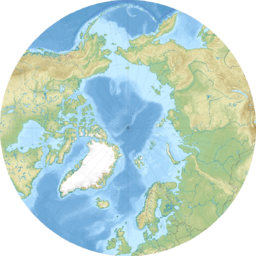| Lincoln Sea | |
|---|---|
 Map of the Lincoln Sea | |
| Coordinates | 83°N 58°W / 83°N 58°W |
| Type | Sea |
| Basin countries | Canada and Greenland |
| Surface area | 64,000 km2 (25,000 sq mi) |
| Average depth | 257 m (843 ft) |
| Water volume | 16,000 km3 (1.3×1010 acre⋅ft) |
| Frozen | Practically all year round |
| References | [1] |
Lincoln Sea (French: Mer de Lincoln; Danish: Lincolnhavet) is a body of water in the Arctic Ocean, stretching from Cape Columbia, Canada, in the west to Cape Morris Jesup, Greenland, in the east. The northern limit is defined as the great circle line between those two headlands. It is covered with sea ice throughout the year, the thickest sea ice in the Arctic Ocean, which can be up to 15 m (49 ft) thick. Water depths range from 100 m (330 ft) to 300 m (980 ft). Water and ice from Lincoln Sea empty into Robeson Channel, the northernmost part of Nares Strait, most of the time.
The sea was named after Robert Todd Lincoln, then United States Secretary of War, on Adolphus W. Greely's 1881–1884 Arctic expedition into Lady Franklin Bay.[2]
Alert, the northernmost station of Canada, is the only populated place on the shore of Lincoln Sea.
The body of water to the east of Lincoln Sea (east of Cape Morris Jesup) is the Wandel Sea.
- ^ R. Stein, Arctic Ocean Sediments: Processes, Proxies, and Paleoenvironment, p. 37
- ^ "Lincoln Sea, a sea in the Arctic Ocean". deepseawaters.com, Phoenix, Arizona. 2012. Retrieved 17 July 2012.
